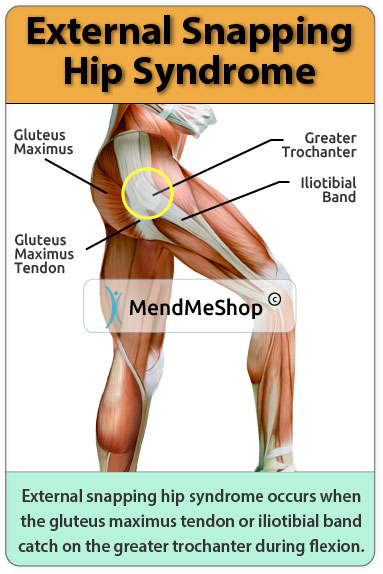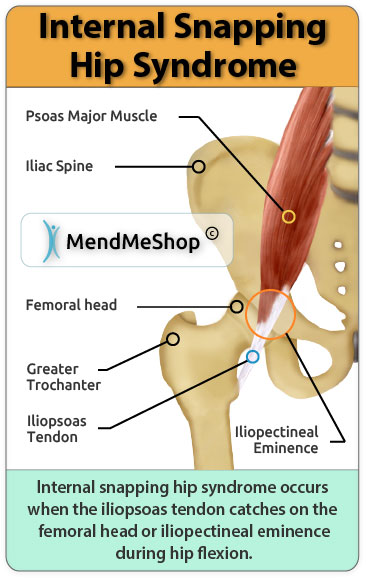Snapping Psoas, Hidden Tiger 30 Sep, 2011 by Katy Bowman
Have you ever gotten up from a sitting position and felt a little tweaky in the hip? Hear an audible click when taking your first few steps after being seated, or a pop when kicking your leg out to the side?
This is a condition (cleverly) called “snapping hip.” Here’s the basic low-down. There can be two things going on. Either your iliotibial (IT) band is snapping in and out of its groove (called external snapping hip) or it’s the tendon of the psoas muscle snapping over a bony protrusion (internal snapping hip) .
Healthy muscle can stretch longer than its resting position length. But years of poor alignment, chronic stress, and other poor physiological habits all create changes within muscle that keeps it from budging. It just stays short and tight all of the time. This isn’t because the muscle is stubborn, but because if it relaxed, you would fall down. You’ve been using the psoas muscles to hold your body upright because of forward thrusting habits and very weak posteriors.
So, tight muscle then transfers its tension to the tendons. (See the article I posted on my website on Snapping Hip Syndrome) tight muscles + tight tendons + bony prominences = tendonitis, then a bone spur, and then a separation (tear) in the tendon itself.
Try this. Lie your head and shoulders on a bolster or stack of pillows, making sure nothing is underneath your ribs.
THIS PICTURE SHOWS WHAT NOT TO DO If your ribs are up in the air when your thighs are down on the ground, then your psoas muscle is not relaxed to the correct length. This is a result of a chronic pelvis tucking and rib thrusting habit. And stress. Did I mention stress?
YOUR BODY SHOULD LOOK LIKE THIS: ribs relaxed=relaxed psoas and you shouldn’t have to contract any muscles to get it there. This should be your relaxed position. It does not count if you have to work your muscles against each other.
Try this assessment, and, if you find your ribs up in the air as in the first picture, just sit with it. There is nothing to “do” to fix it. There is something you can “stop doing” though, and that is holding tension in the trunk.
Close your eyes, and open your mind – going in search of deep-seeded tension. You’re like an onion, so you’ll need to switch off unnecessary muscle in waves, but it’s so worth it.
If you are interested in exploring the amazing psoas more, you can learn a lot from this audio interview I did with Liz Koch, fellow psoas-lovah (click). In fact, you can listen to it while you’re relaxing on the bolster. And, if you really want to know more or have more tools like the one presented today, I can’t recommend my Science of Psoas course enough. It is totally worth it, and that’s not just my opinion. My mom thinks so too. Science of Psoas (click). Peace out!
Treatment for Snapping Hip Syndrome
In the world of CoreWalking treatment for snapping hip syndrome is purely a movement issue. If walk correctly your hip will stop snapping. Snapping hip syndrome strikes me as nothing more than a misaligned body moving in all the wrong ways.
 On the inside and the
outside of the leg, or femur bone, we find two small bony knobs that muscles attach onto. The lesser trochanter is on the inside of the leg and is the attachment point for the iliopsoas muscle—the psoas major and iliacus that meet to form a common tendon.
On the inside and the
outside of the leg, or femur bone, we find two small bony knobs that muscles attach onto. The lesser trochanter is on the inside of the leg and is the attachment point for the iliopsoas muscle—the psoas major and iliacus that meet to form a common tendon.
The greater trochanter is home to a number of muscles including gluteus medius and minimus, the piriformis, the obturator muscles and the gemelli muscles. I’ll save for another post what I have always felt is the significance of one muscle attaching on the lesser trochanter and a whole hosting connecting to the greater trochanter.
Snapping hip syndrome is basically the IT band or gluteus maximus tendon snapping over and around the greater trochanter, or the iliopsoas snapping around the lesser trochanter.
In general there isn’t much by way of treatment for snapping hip syndrome. It often occurs without accompanying pain so people are usually told to not worry about it too much. Those who do suffer pain from a snapping hip aren’t really presented much by way of help either.
Needless to say, the rest ice and ibuprofen as a means of treatment for this condition, though most often offered, doesn’t appeal to me much. Treatment in physical therapy usually includes stretches in hopes of creating longer muscles that will stop snapping around the trochanters. Sometimes cortisone injections are given and occasionally a surgical option is explored.
One thing you don’t see very much is the suggestion that if you walk differently your hip will stop snapping. But I have worked with more than a few sufferers of snapping hip syndrome and I am here to tell you that walking correctly is the easiest and best treatment available.
Why Walking Is The Best Treatment For Snapping Hip Syndrome
To repeat myself for the 900th time (To my amazement I have written over 900 posts) I think everybody leans backwards and walks with a tucked pelvis. This is a very simple formula for snapping hip syndrome.
I teach people to walk by taking the thighs back under the hips and leading from the core instead of the legs. When the legs lead the way the possibilities for snapping the hip increase exponentially as the iliopsoas is pulled forward and the IT Band is pulled backwards in exactly the way they shouldn’t be moving.
When we move successfully from the core and the psoas, the ball, or head, of the femur bone is properly twisted into the hip sockets and there is no reason why any snapping will occur.
I know it is redundant but walking correctly is the answer for so much of what ails us
Snapping Hip Syndrome
Snapping hip syndrome (also called dancer's hip, coxa saltans, and iliopsoas tendinitis) is a snapping or clicking sensation and possible sound in the hip joint that may or may not cause pain. Your hip may also feel that your hip is unstable and may give out.

Snapping hip syndrome occurs when a tendon running along the front or side of the hip flexor pops or snaps over a bone. This occurs when the leg moves from flexion to extension with the iliopsoas, or hip flexor, muscle. Snapping hip syndrome can be divided into different types: external, internal or intra-articular, which depend on where the snap is occurring.
External
The most common occurance of snapping hip syndrome is over the greater trochanter at the top of the femur and is referred to as external clicking hip. During hip flexion, when the leg moves forward, the gluteus maximus contracts and the tendon is pulled over the greater trochanter along with the iliotibial tract (IT band). When the gluteus medius tendon or IT band thickens or frays, it is more likely to catch on the bone. Due to tightness over the trachanteric bursa and irritation in the area, trochanteric bursitis may also develop with this type of snapping hip syndrome.

Internal
This type of snapping hip is less common than external snapping hip syndrome. It occurs when the iliopsoas tendon snaps over the femoral head or iliopectineal eminence. With internal clicking there is a gradual onset over a few months before the clicking may become noticeable. Internal snapping hip syndrome may cause or be trigger by iliopsoas bursitis.
Intra-articular
Loose bodies in the hip joint or other tissue catching, like tissue from a labral tear, can cause intra-articular snapping hip syndrome. The labrum is a unique piece of cartilage that lines the inside of the hip socket. If it becomes damaged or torn, then it can cause a snap or pop in the hip joint itself as it moves.
Risks or Causes of Snapping Hip Syndrome
- Being between 15 and 40 years of age.
- Taking part in sports or activities involving repetitive hip flexion such as running, cheerleading, gymnastics, ballet, or soccer.
- Having tight IT bands, torn labrum or leg length discrepancy.
Treating Your Snapping Hip Syndrome
The treatment for snapping hip syndrome should focus on resting your hip and reducing inflammation to relieve pain.
Gentle exercise can assist you in stretching the gluteus maximus tendon and IT band if they are tight. If the gluteus maximus tendon or iliotibial tract have thickened, frayed and/or become inflamed you can treat the injury to heal your tissue and repair the cause of you snapping hip syndrome. Treating the gluteus maximus tendon and IT band injury with cold compression and alternate with heat to increase Blood Flow to will reduce your pain and speed healing.
In some severe cases of snapping hip syndrome, surgery may be required to trim the catching piece of labrum, remove a loose piece in the joint, or lengthen the tendon that is too tight.
 Movement & stillness
Restorative yoga, Somatics
functional strength
Movement & stillness
Restorative yoga, Somatics
functional strength
